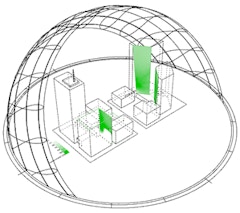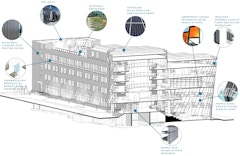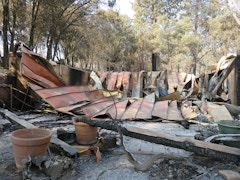
73 results
-
 Facades developed in response to climactic factors increase performance and human comfort while reducing energy loads. A single building envelope…
Facades developed in response to climactic factors increase performance and human comfort while reducing energy loads. A single building envelope… -
Cities under Climate Threat - Philadelphia, Rome and Venice
- Paper by Edgar Stach, Dr., Ing, AIA/IA, Professor Shreya Kanther, Ph.D Candidate Alexis Manfre, Student
The impacts of climate change, driven by increasing extreme temperature, sea-level rise, and heavy precipitations, interact and play an essential… -

U-Factor Matters in Hot Climates
- Paper by Helen Sanders, PhD
It is commonly thought that fenestration U-factor is not a key determinant in the performance of facades in hot climates, and generally the focus of
-

European Facade Networks
- Paper by Ulrich Knaack · Uta Pottgiesser · Tillmann Klein · Andreas Luible · Siebe Bakker
The European climate and energy targets for 2020 demand significant improvement of the energy performance of buildings since one third of the
-

Green Façade/Roofs Design Tool
- Paper by Abolfazl Ganji Kheybari · Morteza Kasravi
Climate change and related thermal issues, draw attention to the impact of green facades and roofs on energy savings and thermal comfort. Besides, by
-
Contextualizing Glass and Carbon Impacts
- Paper by Kayla Natividad, PhD, WELL AP, LEED Green Associate · Kyle Sword
Climate change goals will require significant improvements in the way buildings are constructed and operated. Building reuse can combat climate
-
Wind-Borne Debris Impacts on Façades
- Paper by Angela Mejorin, Ph.D., Researcher
Climate change effects are causing an increase in extreme wind events’ frequency and severity, worldwide. Regions that previously were not prone to
-
Rammed Earth & Wildfire
- Paper by Brittany Dhawan, AIA
California is set to be drier and more drought prone with climate change. Wildfire and the subsequent loss of life and housing is a huge challenge.
-
Dynamic Shading Device
- Paper by Gabriel de Bem · Eduardo Krüger · Alexandre Augusto Alberto Moreira de Abreu
Responsive shading systems can dynamically improve indoor environmental conditions based on outdoor climate variations. Among the technologies,
-

Terra Cotta Skins
- Paper by Laura B. Garofalo, Assistant Professor
This paper will address the potential of ornamental architectural terracotta surfaces to mitigate the effects of climate fluctuations that will… -
3D thermal modelling of complex facades
- Paper by Wout Parys · Piet Houthuys
Today’s building enclosures face ever greater demands regarding their thermal performance. In cold climates, the required total U-value of the façade
-

Build Test Iterate Repeat
- Paper by Elizabeth L McCormick, RA, CPHC, LEED AP, Assistant Professor
The global increase in atmospheric temperature rise combined with the rapid growth of previously underdeveloped climate zones presents a growing need… -

HydroSKIN
- Paper by Christina Eisenbarth, M.Sc. · Walter Haase, Dr.-Ing. · Lucio Blandini, Prof. Dr.-Ing. M.Arch. · Werner Sobek, Prof. Dr.-Ing. Dr.-Ing. E.h. Dr. h.c.
Building envelopes cover a considerable part of the urban exterior surfaces, and to therefore have a significant leverage effect on the climate
-

Rethinking Building Skins
- Paper by Eugenia Gasparri · Arianna Brambilla · Gabriele Lobaccaro · Francesco Goia · Annalisa Andaloro · Alberto Sangiorgio
Building skins play a pivotal role in architecture. Other than the aesthetical and architectural aspects, facades are key to the climate performance,
-

Active and Energy Autonomous Window
- Paper by Annalisa Andaloro, Leire Minguez Hilera, Stefano Avesani,
Reducing GHG emissions related to energy use in buildings is a prominent obligation given their impact in terms of climate change. In this light,… -

Sustainable Retrofit Strategies for an Existing Laboratory Building
- Paper by Suncica Milosevic · Ajla Aksamija
This paper analyzes sustainable retrofit strategies for an existing research laboratory building, located in a cold climate. This facility is
-

Performance of Compact, Closed Cavity, Double-skin Curtain Wall
- Paper by Julien Schwartz, M. Eng., Building Energy Consultant Katie Hay, P. Eng., Building Science Consultant Stéphane Hoffman, M. Arch., M. Eng, PE, Vice President, Building Science Analytics
A proposed design for a compact, closed cavity, double-skin curtain wall system in the Marine climate of the West Coast raises questions of potential… -
Sustainable Façades
- Paper by Dr. Thomas Henriksen, Jean-Marc Moulin Norsk, Dr. Jacopo Montali,
Transposing innovation from government funded research to commercially viable solutions becomes ever more important when combined with the urgent… -
Facades for High-Performance Workplaces
- Paper by Christopher Payne, AIA, LEED AP, Assoc. DBIA
How has the role of the façade evolved in light of the COVID-19 pandemic and ongoing fight to combat the climate change crisis? As companies grapple
-

Shadow Box Design
- Paper by Mark Walsh,
Shadow boxes are commonly used in curtain wall construction, but can be problematic if not designed and detailed correctly and appropriately for the…
